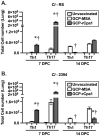A Recombinant Multivalent Vaccine (rCpa1) Induces Protection for C57BL/6 and HLA Transgenic Mice against Pulmonary Infection with Both Species of Coccidioides
- PMID: 38250880
- PMCID: PMC10819930
- DOI: 10.3390/vaccines12010067
A Recombinant Multivalent Vaccine (rCpa1) Induces Protection for C57BL/6 and HLA Transgenic Mice against Pulmonary Infection with Both Species of Coccidioides
Abstract
Coccidioidomycosis is caused by Coccidioides posadasii (Cp) and Coccidioides immitis (Ci), which have a 4-5% difference in their genomic sequences. There is an urgent need to develop a human vaccine against both species. A previously created recombinant antigen (rCpa1) that contains multiple peptides derived from Cp isolate C735 is protective against the autologous isolate. The focus of this study is to evaluate cross-protective efficacy and immune correlates by the rCpa1-based vaccine against both species of Coccidioides. DNA sequence analyses of the homologous genes for the rCpa1 antigen were conducted for 39 and 17 clinical isolates of Cp and Ci, respectively. Protective efficacy and vaccine-induced immunity were evaluated for both C57BL/6 and human HLA-DR4 transgenic mice against five highly virulent isolates of Cp and Ci. There are total of seven amino acid substitutions in the rCpa1 antigen between Cp and Ci. Both C57BL/6 and HLA-DR4 mice that were vaccinated with an rCpa1 vaccine had a significant reduction of fungal burden and increased numbers of IFN-γ- and IL-17-producing CD4+ T cells in the first 2 weeks post challenge. These data suggest that rCpa1 has cross-protection activity against Cp and Ci pulmonary infection through activation of early Th1 and Th17 responses.
Keywords: HLA-DR4 mice; T-cell immunity; Valley fever; coccidioidomycosis; cross-protection; vaccine.
Conflict of interest statement
The authors declare no conflicts of interest.
Figures





Similar articles
-
Glucan-Chitin Particles Enhance Th17 Response and Improve Protective Efficacy of a Multivalent Antigen (rCpa1) against Pulmonary Coccidioides posadasii Infection.Infect Immun. 2018 Oct 25;86(11):e00070-18. doi: 10.1128/IAI.00070-18. Print 2018 Nov. Infect Immun. 2018. PMID: 30104216 Free PMC article.
-
CARD9-Associated Dectin-1 and Dectin-2 Are Required for Protective Immunity of a Multivalent Vaccine against Coccidioides posadasii Infection.J Immunol. 2020 Jun 15;204(12):3296-3306. doi: 10.4049/jimmunol.1900793. Epub 2020 May 1. J Immunol. 2020. PMID: 32358020 Free PMC article.
-
Preclinical identification of vaccine induced protective correlates in human leukocyte antigen expressing transgenic mice infected with Coccidioides posadasii.Vaccine. 2016 Oct 17;34(44):5336-5343. doi: 10.1016/j.vaccine.2016.08.078. Epub 2016 Sep 9. Vaccine. 2016. PMID: 27622300 Free PMC article.
-
Coccidioidomycosis: host response and vaccine development.Clin Microbiol Rev. 2004 Oct;17(4):804-39, table of contents. doi: 10.1128/CMR.17.4.804-839.2004. Clin Microbiol Rev. 2004. PMID: 15489350 Free PMC article. Review.
-
Immune Response to Coccidioidomycosis and the Development of a Vaccine.Microorganisms. 2017 Mar 16;5(1):13. doi: 10.3390/microorganisms5010013. Microorganisms. 2017. PMID: 28300772 Free PMC article. Review.
Cited by
-
Fungal Vaccine Development: State of the Art and Perspectives Using Immunoinformatics.J Fungi (Basel). 2023 May 31;9(6):633. doi: 10.3390/jof9060633. J Fungi (Basel). 2023. PMID: 37367569 Free PMC article. Review.
-
Galleria mellonella Model of Coccidioidomycosis for Drug Susceptibility Tests and Virulence Factor Identification.J Fungi (Basel). 2024 Feb 5;10(2):131. doi: 10.3390/jof10020131. J Fungi (Basel). 2024. PMID: 38392803 Free PMC article.
-
T cell responses to control fungal infection in an immunological memory lens.Front Immunol. 2022 Sep 13;13:905867. doi: 10.3389/fimmu.2022.905867. eCollection 2022. Front Immunol. 2022. PMID: 36177012 Free PMC article. Review.
-
From soil to clinic: current advances in understanding Coccidioides and coccidioidomycosis.Microbiol Mol Biol Rev. 2024 Dec 18;88(4):e0016123. doi: 10.1128/mmbr.00161-23. Epub 2024 Oct 4. Microbiol Mol Biol Rev. 2024. PMID: 39365073 Review.
-
Challenges to Implementing a Vaccine for Coccidioidomycosis.Open Forum Infect Dis. 2024 Feb 19;11(6):ofae095. doi: 10.1093/ofid/ofae095. eCollection 2024 Jun. Open Forum Infect Dis. 2024. PMID: 38887487 Free PMC article.
References
-
- Galgiani J.N., Ampel N.M., Blair J.E., Catanzaro A., Geertsma F., Hoover S.E., Johnson R.H., Kusne S., Lisse J., MacDonald J.D., et al. Executive Summary: 2016 Infectious Diseases Society of America (IDSA) Clinical Practice Guideline for the Treatment of Coccidioidomycosis. Clin. Infect. Dis. 2016;63:717–722. doi: 10.1093/cid/ciw538. - DOI - PubMed
-
- Neafsey D.E., Barker B.M., Sharpton T.J., Stajich J.E., Park D.J., Whiston E., Hung C.Y., McMahan C., White J., Sykes S., et al. Population genomic sequencing of Coccidioides fungi reveals recent hybridization and transposon control. Genome Res. 2010;20:938–946. doi: 10.1101/gr.103911.109. - DOI - PMC - PubMed
Grants and funding
LinkOut - more resources
Full Text Sources
Research Materials
Miscellaneous

